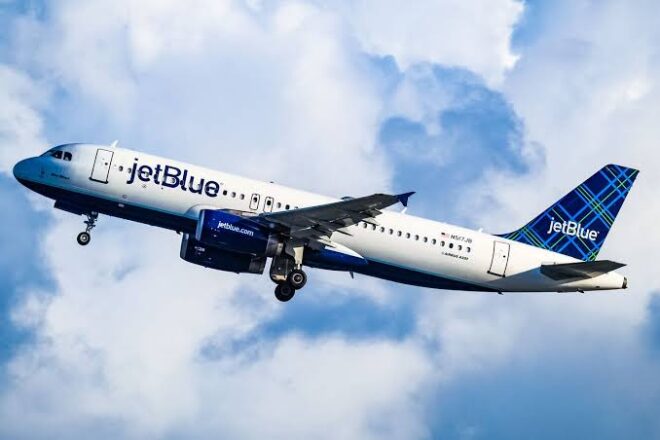
JetBlue Airways, a prominent low-cost airline in the United States, has earned a reputation for its customer-focused approach, budget-friendly pricing, and commitment to offering a premium flying experience. Founded in August 1998 by David Neeleman, JetBlue aimed to revolutionize the aviation industry by combining affordable air travel with a superior in-flight experience. The airline began operations in February 2000, with its first flight between Buffalo, New York, and Fort Lauderdale, Florida.
JetBlue’s inception was based on a simple but powerful idea: provide low-cost air travel without compromising on service. Neeleman, who had previously worked with other airline ventures, sought to fill a gap in the industry by focusing on a business model that combined low fares with a passenger-friendly experience. While other low-cost airlines prioritized minimizing services to cut costs, JetBlue adopted a different strategy by providing added value for passengers. This included offering free in-flight entertainment, more legroom, and complimentary snacks—features that were, at the time, uncommon in the budget airline sector.
JetBlue’s distinctive blue-and-white planes soon became a familiar sight in the skies, particularly on the East Coast, where the airline focused much of its early operations. With its hub at New York City’s John F. Kennedy International Airport (JFK), JetBlue quickly expanded its routes, adding destinations across the U.S., the Caribbean, and Latin America. It became known for operating new, fuel-efficient aircraft, primarily the Airbus A320 and, later, the A321.
One of the key factors behind JetBlue’s growth was its focus on customer experience. By providing perks such as free Wi-Fi, individual entertainment screens at every seat, and premium snack options, the airline differentiated itself from other low-cost carriers, which typically offered minimal services. JetBlue also introduced a tiered fare system, allowing passengers to choose from a range of options based on their budget and desired services, making it a flexible choice for many travelers.
JetBlue’s business model is centered around offering competitive prices without sacrificing quality. The airline strives to maintain lower operating costs through efficient fuel use and strategic route planning while simultaneously enhancing the passenger experience. Its customer-first approach is reflected in its operational decisions, such as the inclusion of “Even More Space” seats that provide additional legroom for passengers willing to pay a premium for extra comfort.
The airline operates a fleet primarily composed of Airbus A320 and A321 aircraft, but it has also introduced Embraer E190 jets for shorter regional flights. These aircraft are known for their fuel efficiency and advanced technology, allowing JetBlue to keep operating costs lower while maintaining a modern, comfortable fleet. JetBlue has also invested heavily in upgrading its fleet with newer, more fuel-efficient planes, which is not only good for the environment but also helps reduce the airline’s operating costs, passing those savings on to customers.
In recent years, the airline announced plans to acquire more fuel-efficient Airbus A220 aircraft, which are expected to replace some of the older Embraer planes. These new aircraft are part of JetBlue’s broader strategy to modernize its fleet, reduce carbon emissions, and provide passengers with a quieter, more comfortable flight experience.
As JetBlue grew, it expanded its route network beyond its initial domestic focus. The airline now serves numerous international destinations, particularly in the Caribbean and Latin America. Popular destinations include Cancun, Mexico; San Juan, Puerto Rico; and Santo Domingo, Dominican Republic. JetBlue’s entry into the transatlantic market with flights between New York and London marked a significant milestone in the airline’s expansion, further diversifying its offerings and increasing competition on high-demand routes.
Despite its successes, JetBlue has faced its share of challenges. As with all airlines, the COVID-19 pandemic had a profound impact on JetBlue’s operations. With global travel restrictions and decreased demand, the airline was forced to reduce its flights, ground planes, and implement cost-cutting measures to survive. However, JetBlue managed to weather the storm better than some of its competitors, thanks in part to its strong domestic network and customer loyalty. The airline quickly adapted by emphasizing health and safety measures, implementing enhanced cleaning protocols, and offering flexibility in bookings to reassure travelers.
Another major challenge came in the form of increasing competition from ultra-low-cost carriers (ULCCs) such as Spirit Airlines and Frontier Airlines, which have taken the low-cost model even further by offering rock-bottom fares in exchange for no-frills service. To stay competitive, JetBlue has had to strike a delicate balance between maintaining its low-cost structure while continuing to provide the level of service its customers expect.
JetBlue has also made strides in its commitment to sustainability and social responsibility. The airline has set ambitious goals to reduce its carbon footprint and has invested in carbon offset programs, including a commitment to achieve carbon neutrality for all domestic flights. It was the first U.S. airline to voluntarily offset its carbon emissions on a large scale.
Additionally, JetBlue has invested in sustainable aviation fuel (SAF), which has the potential to significantly reduce greenhouse gas emissions compared to traditional jet fuel. The airline is working closely with suppliers and industry partners to promote the use of SAF, reflecting its broader commitment to environmental stewardship.
JetBlue remains one of the most dynamic players in the U.S. airline industry. With its focus on customer satisfaction, innovation, and expansion into new markets, the airline is well-positioned to continue growing in the coming years. However, it will face ongoing challenges from increasing competition, fluctuating fuel prices, and evolving passenger expectations.
As the airline prepares for the future, its ability to adapt while staying true to its core values—offering affordable flights with a premium experience—will determine its continued success. Whether through modernizing its fleet, exploring new routes, or enhancing its environmental initiatives, JetBlue aims to remain a leading choice for travelers looking for both value and comfort.